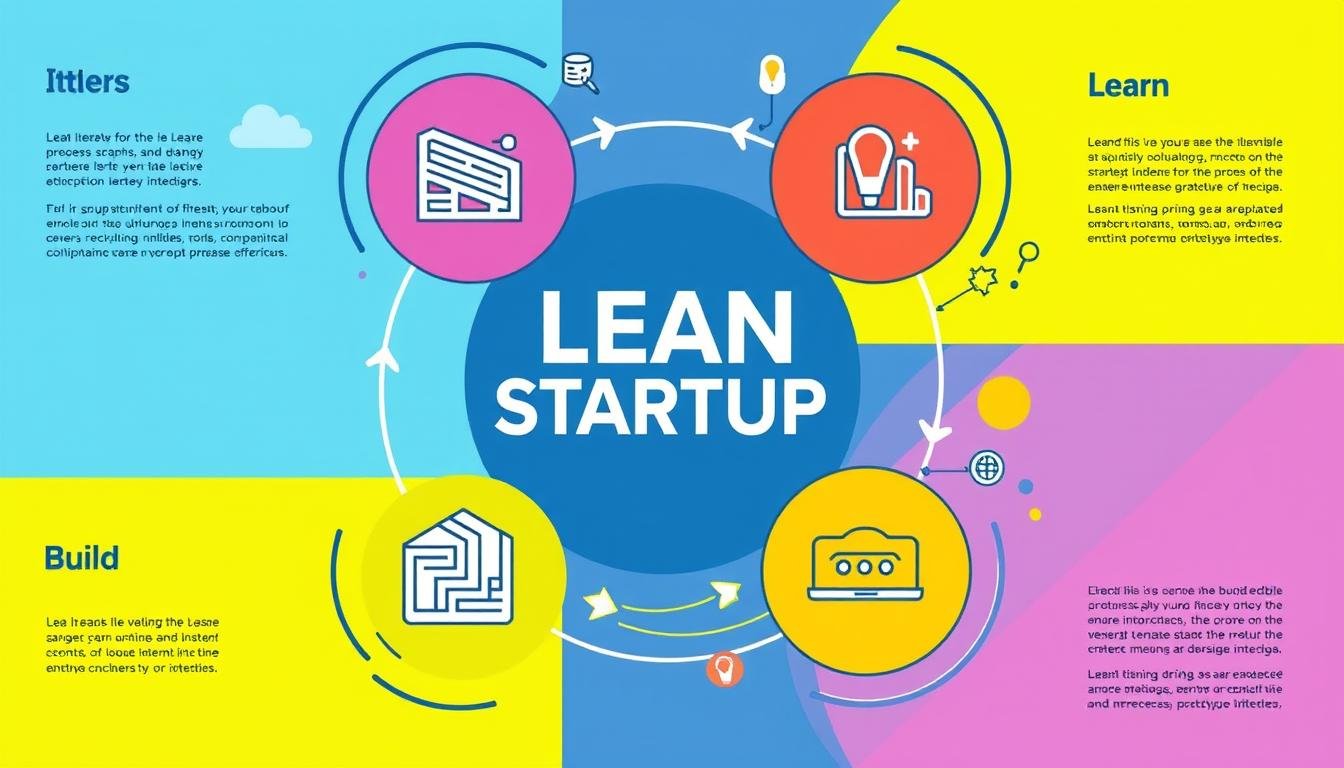Mastering Lean Startup: Innovate Smarter, Faster
What if the secret to doing well in a fast-changing market isn’t in big business plans? It’s in the Lean Startup method that pushes for quick tests and learning. This approach, made popular by Eric Ries over a decade back, is a game-changer for entrepreneurs wanting to innovate quicker and smarter.
The Lean Startup way is all about cutting waste and making things that customers really want. It’s about learning from your customers and making improvements in a structured way. This is similar to how top companies like Toyota work efficiently. We’ll explore these key ideas, showing how using Lean Startup can change your business for the better.
Key Takeaways
- The Lean Startup method is all about quick tests, not long plans.
- Learning from customers and cutting waste are key to making new products.
- Every product and marketing move should be seen as a way to get customer feedback.
- Success can be learned and shared through Lean Startup processes.
- Always keep improving and adapting in today’s fast-paced business world.
Introduction to Lean Startup Methodology
The Lean Startup methodology changes how entrepreneurs start, grow, and launch their businesses. It focuses on learning and responding to what customers want. By following its core principles, startups can increase their success chances and build lasting businesses.
Understanding the Core Principles
The Lean Startup is all about learning and improving through product development. Key principles include:
- Build-Measure-Learn: Making a basic product to test ideas fast.
- Customer-centric approach: Using customer feedback to shape the product.
- Minimization of waste: Cutting down on unnecessary costs and steps early on.
This approach tells entrepreneurs to see failure as a way to learn and move forward. It’s about making quick changes based on what customers say, not just sticking to a detailed plan.
The Evolution of Lean Startup Practices
Eric Ries introduced the Lean Startup in 2008 through his book. Since then, companies like Zappos and General Electric have used it to grow. This method’s flexibility has made it key in today’s fast-changing market, encouraging a culture of trying new things and getting feedback.
The Lean Startup changes the way businesses start, focusing on being quick and customer-focused. It’s impacting new and old companies, shaping the future of starting businesses.
Challenges of Traditional Business Planning in Startups
Startups face big hurdles when they stick to old-school business planning methods. These methods can make their plans too rigid, not flexible enough for today’s fast-changing markets. The need for quick changes makes the old ways less effective.
Long development times and big plans can slow down innovation. Entrepreneurs might spend too much time on detailed documents. This can mean missing out on what customers really want.
This can lead to launching products that no one wants. In today’s world, being able to quickly adapt is key.
Limitations of Conventional Approaches
Traditional business planning has its downsides. It can waste resources and miss out on chances to grow. Long plans can make it hard to focus on doing things, not just planning them.
This can mean ignoring what customers think early on. It’s a big mistake in a world where fast changes are the norm.
- Lengthy development cycles can stifle innovation.
- High resource investments in unvalidated concepts.
- Difficulty in pivoting strategies based on market feedback.
Adapting to a Rapidly Changing Market
To succeed today, startups need to be flexible. Lean Startup methods offer a better way. They focus on quick prototyping and making changes as they go.
This approach helps startups quickly figure out their unique selling points. It lets them adjust fast to what customers say. It also lowers the risk of launching products no one wants.
Research from Harvard Business School shows that 75% of startups fail because they don’t match the market. Using flexible methods can help avoid this. Lean principles let startups quickly respond to changes and customer feedback. This way, they can offer what customers really want.
Implementing Lean Startup Framework Effectively
To succeed with the Lean Startup framework, it’s key to know its main parts. This approach puts customer validation first and focuses on learning in small steps. By entering the market early, startups get quick feedback and can make changes fast.
Key Components of the Lean Framework
The Lean Startup framework has some key parts that make it work well:
- Validated Learning: Uses real data to check if a product will work.
- Build-Measure-Learn Feedback Loop: Encourages quick changes through ongoing cycles of improvement.
- Customer Focus: Makes sure products meet what customers want and like.
- Iterative Development: Takes an agile way to improve offerings with new insights.
- Lean Thinking: Reduces waste and uses resources wisely.
Building Minimum Viable Products (MVPs)
The idea of the minimum viable product (MVP) is central to the Lean Startup method. An MVP lets entrepreneurs start with a basic set of features, get customer feedback, and lower risks. Amazon is a great example of this, starting with an MVP to get into the market.
By making MVPs, startups can follow the Build-Measure-Learn loop. This leads to:
| Stage | Description | Outcome |
|---|---|---|
| Build | Develop an MVP with key features. | First user interaction and data collection. |
| Measure | Get feedback and look at how users behave. | Learn what customers like and how the product does. |
| Learn | Use what you’ve learned to improve or change the product. | Make the product better match what the market wants. |
Using these ideas makes companies more agile. Lean startups can quickly adjust to changes in the market and reduce financial risks. This is a big plus in today’s fast-changing business world.
Customer Validation Through Continuous Innovation
The Lean Startup method focuses on checking if products match what customers want. It’s key to making sure products hit the mark. Customer feedback is vital for making products better over time. It helps entrepreneurs tweak their products to better serve consumers.
The Role of Customer Feedback in Iteration
Listening to customers helps startups keep innovating. This feedback shapes the build-measure-learn cycle. It shows how customers react to the product. By acting on this feedback, startups can boost their chances of success.
Strategies for Engaging Early Adopters
Getting early adopters on board is crucial for Lean Startups. These users offer valuable insights and support. Startups can engage them by:
- Leverage Social Media: Use platforms to get insights and build a community.
- Host Webinars: Share updates on product development and ask for feedback.
- Offer Incentives: Give early adopters special deals to encourage participation.
- Develop Beta Programs: Let early adopters try new features or products.
These strategies help startups build strong ties with early users. This leads to better customer validation and ongoing innovation.
| Strategy | Description | Benefits |
|---|---|---|
| Leverage Social Media | Gather insights and foster community engagement. | Enhanced visibility and real-time feedback. |
| Host Webinars | Share product stages and invite participant feedback. | Builds trust and encourages user interaction. |
| Offer Incentives | Entice early adopters to participate actively. | Increased enrollment and motivated feedback. |
| Develop Beta Programs | Involve early adopters in testing features. | Timely insights into user preferences and product fitness. |
Conclusion
The Lean Startup principles change how businesses innovate and grow. They focus on learning from the audience and adapting quickly. This way, startups can meet market needs better.
Many startups fail because they stick to old strategies and don’t match the market. But, using the Lean Startup method gives a big advantage. Agile companies grow more, with revenue up to 37 percent higher and profits 30 percent above others.
This shows how important it is to know what customers need and change to meet those needs.
The Lean Startup method helps founders and leaders to succeed. It teaches building, measuring, and learning. This way, businesses can innovate and be resilient.
The key to success is creating a place where learning and adapting happen. This ensures that companies deliver value to customers in today’s fast-changing world.
Source Links
- The Lean Startup book, 10 years after: how did if fare across time?
- Lean Startup Books
- Book Summary: “The Lean Startup” — A Strategic Guide to Mastering Innovation
- What Is the Lean Startup Methodology?
- Lean Startup: Defined, How It Differs From a Traditional Business
- Lean Startup Methodology
- Lean Startup vs Traditional Business Plan — NEXEA
- Why the Lean Start-Up Changes Everything
- Traditional business plan vs. lean startup business plan | Firmbee
- What is the lean startup methodology? How to apply it?
- Lean Startup
- The Lean Startup | Methodology
- How to anchor continuous customer validation in your innovation process?
- How do you use lean startup methods to validate customer needs?
- The Lean Startup summary. Methodology overview — molfar.io
- Lean Startup Summary: A Must Read for Every Founder







